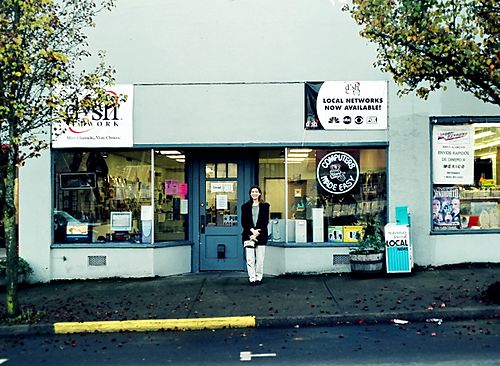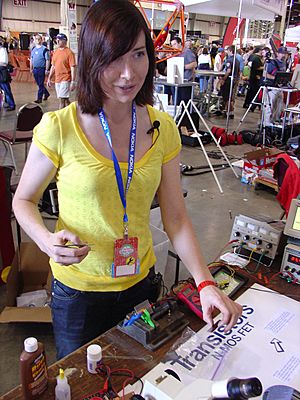Jeri Ellsworth facts for kids
Quick facts for kids
Jeri Ellsworth
|
|
|---|---|

Ellsworth at California Extreme (Classic Arcade Games Show), 2009
|
|
| Born | August 14, 1974 Georgia, United States
|
| Occupation | Entrepreneur Integrated circuit designer |
| Employer | Tilt Five |
| Website | jeriellsworth |
Jeri Janet Ellsworth (born August 14, 1974) is an American inventor and designer of computer chips. She is also an entrepreneur, which means she starts and runs her own businesses.
Jeri became well-known in 2004 for creating a special computer chip. This chip could act like a full Commodore 64 computer, but it was small enough to fit inside a joystick. This invention was called the Commodore 30-in-1 Direct to TV. It let people play 30 classic video games from the 1980s. At its most popular, over 70,000 units were sold in just one day on the QVC shopping channel.
Later, Jeri worked for Valve Corporation, a company that makes video games and hardware. She helped develop augmented reality (AR) devices there. After leaving Valve, she co-founded a company called castAR to continue her AR work. Although castAR closed down in 2017, Jeri started a new company, Tilt Five. This company also creates AR hardware using similar ideas.
Jeri Ellsworth has also shared her knowledge about various "homebrew" projects. These include how to make semiconductor chips and electroluminescent displays at home.
Contents
Early Life and Discoveries
Jeri Ellsworth was born in Georgia, USA. She grew up in Oregon, in towns like Dallas, Oregon and Yamhill, Oregon. Her mother passed away when Jeri was only one year old. Her father, Jim, who was a car mechanic, raised her.
When Jeri was eight, she loved taking her toys apart. She wanted to see how they worked inside. Her father supported her curiosity. He stopped buying her new toys and instead gave her broken electronic gadgets from his car repair shop. Jeri learned to fix and change these items. She also convinced her father to let her use a Commodore 64 computer. She taught herself how to program by reading the computer's manual. To earn money, she helped her father at his service station. She pumped gas, cleaned tools, and did other mechanical tasks.
In high school, Jeri and her father raced dirt track racing cars. She started designing new car models in his workshop. Eventually, she began selling custom-made race cars. She left high school early to focus on her successful car business.
Starting Computer Businesses
In 1995, when Jeri was 21, she decided to try something new. She and a friend started a business building and selling computers. These computers used the Intel 486 microprocessor. After a disagreement with her partner, Jeri opened her own competing business.
Her new business grew into a chain of four stores called "Computers Made Easy." These stores sold electronics and offered repair services in towns like Canby, Monmouth, and Albany, Oregon.
By 2000, it became harder to make a good profit from the stores. So, Jeri sold her chain of businesses. She then moved to Walla Walla, Washington, to study circuit design at Walla Walla College. However, she left after a year. She felt that asking questions in class was not encouraged, which didn't fit her learning style.
Designing Computer Hardware
In 2000, Jeri Ellsworth showed off a new video expansion for the Commodore 64 computer. This was at a Commodore Exposition. After this, she began designing digital circuits. These circuits were made to act just like the parts of a C64.
In 2002, she designed the main chip for the C-One. The C-One was an improved C64 that could also act like other old home computers from the early 1980s, such as the VIC-20 and ZX81. Jeri and another developer showed the C-One at a technology conference. This led to a company hiring her to design the "computer in a chip" for the C64 Direct-to-TV joystick.
She started this project in June 2004. By Christmas of that year, the product was ready to sell. It sold over half a million units in the US, Europe, and other places. Jeri did not receive the payment or commission she was promised for this work. However, a story about her in the New York Times newspaper made her famous.
Jeri has also shared how to build a special scanner using old satellite parts. She has worked on many different projects. These include making semiconductors at home in 2009. In 2010, she showed how to make electroluminescent (EL) displays. She also found ways to make EL materials from common ingredients.
On February 25, 2010, the website Lifehacker called Jeri Ellsworth the "MacGyver of the Day." This was because of her clever ways of building things. Jeri works as a freelance designer for special computer chips called ASICs and FPGAs.
Innovations in Augmented Reality
In early 2012, Jeri Ellsworth and other hardware experts were hired by Valve. They worked on new gaming hardware. In 2013, Jeri left Valve.
On May 18, 2013, Jeri announced a new augmented reality (AR) system. It was called castAR. She developed it with Rick Johnson, another engineer who used to work at Valve. Valve's co-founder, Gabe Newell, gave them his blessing to continue this work. They planned to get funding for castAR through Kickstarter.
Jeri later shared that she had been secretly working to make castAR capable of "true VR and true AR." This was in addition to the projected AR features they had already announced. The castAR Kickstarter campaign started on October 14, 2013. It quickly reached its goal of $400,000 in just 56 hours. The campaign ended up raising over $1 million, which was 263% of their original goal. However, the company, Technical Illusions, was not able to deliver the devices. They returned the money to their supporters before closing down in 2017.
In September 2019, Jeri started another Kickstarter campaign for a new device. This device, called Tilt Five, was based on the same ideas as castAR. This new Kickstarter was even more successful. It reached its goal of $450,000 in just 17 hours. It eventually raised over $1.7 million. The first products were planned for June 2020. Manufacturing was delayed by the global pandemic, but the company has continued to sign contracts with gaming companies.
Public Appearances
Jeri Ellsworth was a main speaker at the Embedded Systems Conference on May 5, 2011.
From December 2008 to March 2009, Jeri hosted a weekly webcast called Fatman and Circuit Girl. She hosted it with musician George Sanger. On May 30, 2009, Jeri showed her Home Chip Lab at the Maker Faire Bay Area.
Personal Life and Hobbies
Jeri Ellsworth loves pinball machines. She owns more than 80 of them! In 2016, she became a licensed amateur radio operator. This means she can use a special radio to talk to people around the world. Her call sign is AI6TK.
See also
 In Spanish: Jeri Ellsworth para niños
In Spanish: Jeri Ellsworth para niños



